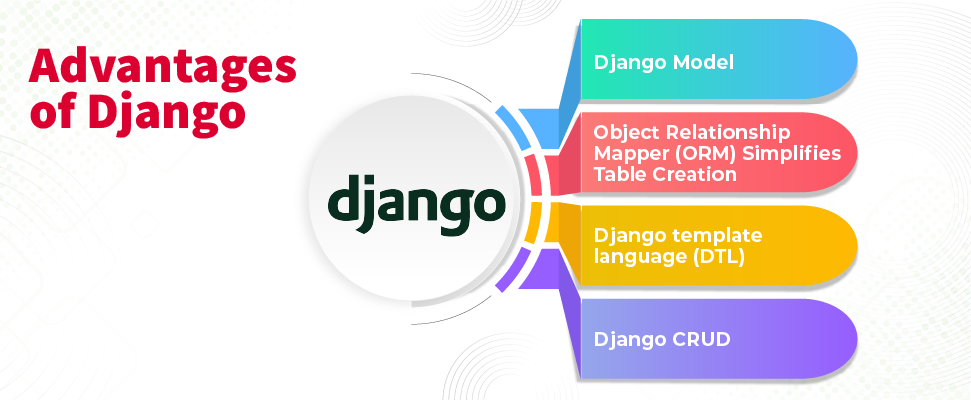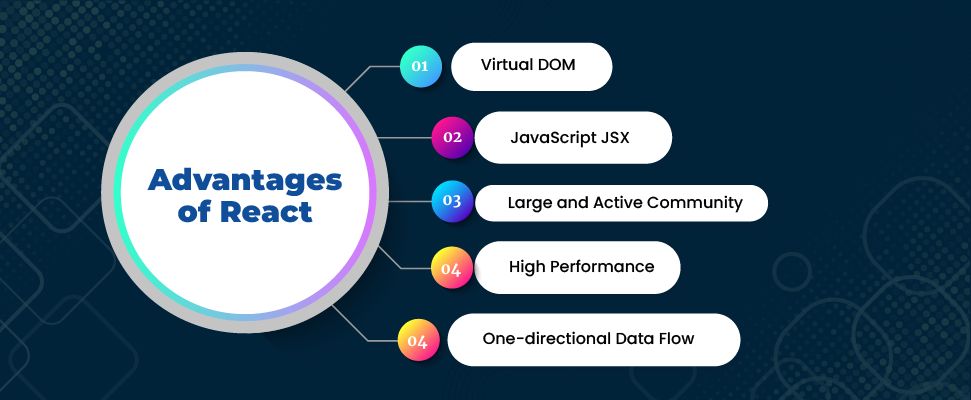Table of Contents
ToggleIntroduction
Frameworks offer ready-made tools and libraries to develop web applications quickly, easily, and efficiently. Frameworks are an integral part of the programming world. Today, in this article, we’ll explore two popular frameworks; Django and React. Django is a full-stack framework for Python and React is a JavaScript library used for creating impressive UI. Read on to know more:
Django: Full-stack Python Web Framework
Introduced in the year 2005 by the non-profit independent foundation as a high-level full-stack web framework for Python, Django is a perfect solution for building a fast web app offering high quality and clear code. It follows the Model View Template (MVT) structure where the model takes care of the database logic of the application and views handle the business logic such as function and class. Its template is responsible for front-end and presentation logic such as HTML, CSS, and JS.
Django follows the Don’t Repeat Yourself (DRY) principle that encourages code reuse and minimizes the likelihood of errors. Moreover, it offers built-in tools such as site maps, content administration, RSS feeds, and authentication that simplify the process of developing web applications. In terms of security, Django provides cross-site scripting, SQL injection, clickjacking, and cross-site forgery.
Read More- Django in Python
Advantages of Django

- Django Model: Python developers do not need to write the SQL query to retrieve, create, delete, and update from the database. Django model provides a database abstraction API that handles these seamlessly. It follows the single SQL database structure through which organizing database-related tasks becomes simple. Besides, it offers features like advanced metadata management, compatibility, and version control for efficient data handling.
- Object Relationship Mapper (ORM) Simplifies Table Creation: Developers can create a database table without writing lengthy and complex SQL queries. Django uses ORM to generate an automatic database table (Model) and links it with the front end of your program.
- Django template language (DTL): Python code cannot be combined directly with HTML as both are different types of programming language. Web browsers cannot interpret Python code. To bridge the gap, Django provides DTL that can embed dynamic elements within the HTML file. Thus, DTL defines the front-end part of the program in Python.
- Django CRUD: Python developers don’t need to have profound knowledge of SQL. Neither do they need to delve into the complexities of database management. CRUD handles the fundamental operations of a database. ORM provides the commands for SQL queries that simplify the process.

Don't miss out on your chance to work with the best!
Apply for top job opportunities today!
Why Should You Consider Django?
- Django promotes faster development.
- Django can handle high-traffic demands as it is highly scalable.
- ORM ensures the effective interaction between the application and the database.
- It provides plenty of libraries that are enough to write basic functionalities.
- Django prioritizes security.
- A large and active community always ready to help in times of trouble.
- It is updated every 8 months to fix the bugs and security.
- Django can handle a large number of tasks and increased load at the same time.
- It provides a built-in administration portal.
When Should You Not Consider Django?
Although Django is an exceptional framework for Python there are a few places where it is not suitable.
- Django is not the best option for real-time operation as it doesn’t support WebSockets.
- Django by default is not suitable for creating the RESTful APIs.
React: JavaScript Library for Building Dynamic Web UI
React is a component-based JavaScript library that has dominated the front-end ecosystem since its release. Using React, developers can create a large and complex Web UI without a frequent page refresh. And the best part is that even if you’re not familiar with TypeScript, you can still use React. It follows the Model View Controller (MVC) architecture pattern. Furthermore, its main goal is to provide a better user experience with robust and blazing–fast web applications.
Advantages of React

- Virtual DOM: React does not interact with the browser DOM. It has its own virtual DOM that can manage and control the browser’s DOM. Interestingly, its virtual DOM can create more than 200,000 nodes per second which can significantly improve the performance and speed.
- JavaScript JSX: JSX makes writing markup for any components super easy in React. It also provides a convenient way to link functions to the element in UI.
- Large and Active Community: React has a large and active community ready to help with apropos documentation. It also offers a huge collection of third-party tools, libraries, and resources.
- High Performance: React comes with its own virtual DOM, which significantly contributes to its performance. Whenever any changes occur in the application it directly displays on the webpage and diff algorithm ensures only the necessary nodes of browser are updated.
- One-directional Data Flow: This ensures clear and predictable data flow. If there are any changes it will automatically re-render and reflect the change. Apart from that, this feature promotes a seamless synchronization across components.
What Are the Benefits of Using React?
- It offers a high degree of flexibility with maximum responsiveness.
- Virtual DOM makes the React application blazing fast.
- Data binding guarantees immutability.
- Its open-source code is improved daily.
- It is lightweight so user interactions are handled efficiently by the server.
What Are the Disadvantages of React?
- Solutions are shared rapidly so finding the right instruction can be a bit chaotic.
- Poor support for cross-browser.
Read More- Svelte vs React - Which Framework Is Better?
React vs. Django: What’s the Difference?
| Factors | Django | React |
|---|---|---|
| Types of Frameworks | Python-based full-stack framework | JavaScript library for front-end development |
| Development of UI | It uses a template for client-side rendering | It uses declarative components for UI development |
| Security | Robust security | Not secure |
| Building UI | It uses template | It uses component |
| APIs and Data Handling | ORM handles the database operations. Best suited for data intensive projects. | React interacts with APIs; best suited for Single Page Application (SPA). |
| Project Suitability | Suitable for both large and small projects | Suitable for both large and small projects |
| Performance/ Scalability | Its organized approach provides seamless scalability for complex applications. | High-performance for UI rendering |
| SEO-Friendly | It provides out-of-the-box support for server-side rendering. | It requires third-party tools for SEO-friendly rendering. |
| Learning Curve | It is a lot easier to learn due to concise and clear syntax. | Familiarity with JavaScript can help to start. |
Final Verdict - Django vs. React: Which is the Best Framework?
Django offers high flexibility and security; making it the best option for rapid development with minimal code. It is easy to learn, and lightweight, thus making it perfect for both small and large projects. On the other hand, React is popular for its component-based architecture. It is best for creating complex and simple UIs for web applications. If you want to work with a framework that is easy to set up and learn, Django will be the ideal choice for you. And if you want to develop interactive and impressive web UI, then React is your best tool.
FAQs
React follows the principles of components, and state management, as well as combines the code of JSX and HTML-like code into one unit. This promotes code modularity and reusability.
Single-page applications (SPAs) and Progressive web apps (PWAs).
Django provides a high degree of security to your web applications by implementing SQL injection and Cross-Site Request Forgery (CSRF).
Django offers the best security, due to which it makes suitable fo r creating e-commerce platforms, government industries, Data-driven applications, finance sectors, and content management systems.
React is a library for building web UIs and Django is a framework used for full-stack development. Both languages are used for different purposes; thus, to pinpoint one as superior is challenging. But that being said, ReactJS is well-suited for creating fast and responsive UI. Django is the best for rapid development and building scalable web apps.
Yes, of course. Django and ReactJS will be a powerful combo pack that can create fast, performant, and highly scalable web apps.
Take control of your career and land your dream job!
Sign up and start applying to the best opportunities!


